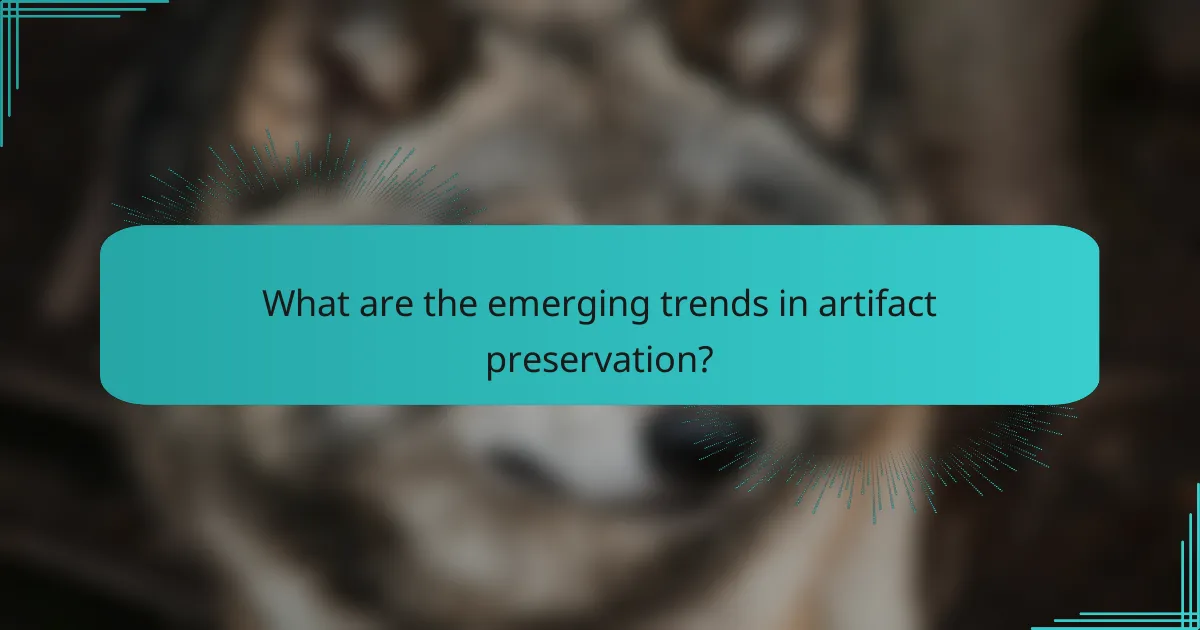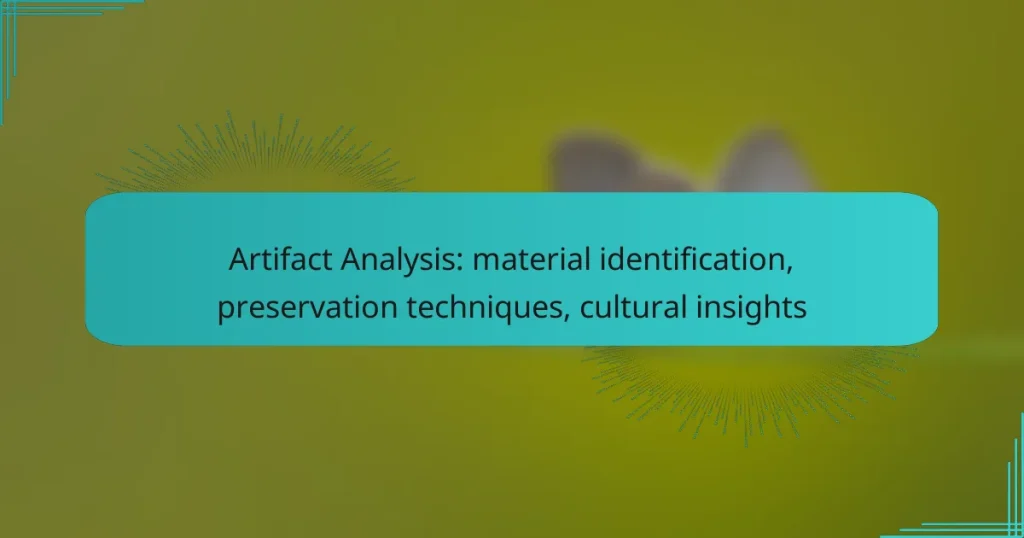Artifact analysis plays a crucial role in understanding the materials, preservation techniques, and cultural insights associated with historical objects. By identifying materials and employing effective preservation methods, we can maintain the integrity of artifacts, allowing future generations to appreciate their historical significance. These tangible representations of culture offer valuable insights into the values, beliefs, and practices of past societies.

How to identify materials in artifacts?
Identifying materials in artifacts involves examining physical characteristics and employing scientific methods. This process helps in understanding the artifact’s origin, age, and cultural significance.
Visual inspection techniques
Visual inspection is the first step in material identification. Look for color, texture, and surface patterns, which can provide initial clues about the material. For example, ceramics often have a glossy finish, while metals may show signs of oxidation.
Using a magnifying glass can enhance your ability to see fine details such as grain patterns in wood or the weave in textiles. Documenting your observations with photographs can also aid in later analysis.
Scientific analysis methods
Scientific analysis methods provide more precise identification of materials. Techniques such as X-ray fluorescence (XRF) can determine the elemental composition of metals and ceramics, while Fourier-transform infrared spectroscopy (FTIR) is useful for identifying organic materials like textiles and leather.
Consider the cost and accessibility of these methods, as some may require specialized equipment or professional expertise. Collaborating with local universities or museums can often provide access to these resources.
Common material types in Canadian artifacts
Canadian artifacts commonly include materials such as wood, stone, metal, and ceramics. Indigenous artifacts often utilize locally sourced materials, with wood being prevalent in tool-making and stone used for implements and ceremonial items.
Understanding the context of these materials is crucial. For instance, the use of copper in artifacts from the Great Lakes region reflects trade networks and technological advancements. Recognizing these patterns can provide deeper insights into cultural practices and historical interactions.

What preservation techniques are effective?
Effective preservation techniques include climate control, proper cleaning and restoration, and suitable storage solutions. These methods help maintain the integrity and longevity of artifacts, ensuring they can be appreciated by future generations.
Climate control measures
Climate control measures are essential for preserving artifacts, as temperature and humidity fluctuations can cause deterioration. Maintaining a stable environment typically involves keeping temperatures between 18-22°C and relative humidity around 45-55%.
Using dehumidifiers and air conditioning systems can help achieve these conditions. Regular monitoring with hygrometers and thermometers is crucial to prevent mold growth and material degradation.
Cleaning and restoration practices
Cleaning and restoration practices must be approached with caution to avoid damaging artifacts. Use soft brushes and lint-free cloths for dusting, and avoid harsh chemicals that can cause irreversible harm.
When restoring artifacts, consider using reversible methods and materials. For example, using archival-quality adhesives ensures that any repairs can be undone without damaging the original item.
Storage solutions for artifacts
Proper storage solutions are vital for artifact preservation. Use acid-free boxes and tissue paper to protect items from dust and physical damage. Shelving should be sturdy and capable of supporting the weight of the artifacts.
Consider the use of display cases with UV-filtering glass to protect items from light exposure. Ensure that the storage area is clean, dry, and free from pests to further safeguard the artifacts.

How do artifacts reflect cultural insights?
Artifacts serve as tangible representations of cultural values, beliefs, and practices. They provide a window into the past, revealing how societies functioned, what they valued, and how they interacted with their environment.
Symbolism in indigenous artifacts
Indigenous artifacts often carry deep symbolic meanings that reflect the beliefs and traditions of the culture they originate from. For example, totem poles from Native American tribes symbolize lineage and spiritual beliefs, while pottery designs may represent local flora and fauna, showcasing the connection to nature.
Understanding the symbolism in these artifacts requires context about the specific culture and its history. Engaging with local indigenous communities can provide valuable insights into the meanings behind various artifacts, enhancing appreciation and preservation efforts.
Historical context of artifacts in Canada
In Canada, artifacts from various indigenous groups illustrate the rich tapestry of cultural history across the nation. Items such as tools, clothing, and ceremonial objects reveal how different tribes adapted to their environments and interacted with European settlers.
Preserving these artifacts is crucial for maintaining cultural heritage. Institutions like museums often follow guidelines set by the Canadian Conservation Institute to ensure proper care and display, which includes controlling temperature and humidity levels to prevent deterioration.

What are the prerequisites for artifact analysis?
Artifact analysis requires specific tools, trained personnel, and a solid understanding of preservation techniques. These prerequisites ensure accurate material identification and effective conservation strategies.
Required tools and equipment
Essential tools for artifact analysis include microscopes, spectrometers, and various cleaning materials. Microscopes help in examining surface details, while spectrometers assist in identifying materials through their chemical composition.
Additionally, preservation supplies such as archival boxes, acid-free tissue paper, and humidity control devices are crucial for maintaining artifacts in optimal conditions. Investing in quality equipment can significantly enhance the analysis process.
Training and expertise needed
Professionals involved in artifact analysis typically require a background in archaeology, anthropology, or a related field. Specialized training in material science or conservation techniques is also beneficial for accurate assessments.
Hands-on experience is vital; apprenticeships or internships in museums or research institutions can provide practical skills. Continuous education through workshops or certifications can further enhance expertise in the latest preservation methods and technologies.

What are the emerging trends in artifact preservation?
Emerging trends in artifact preservation focus on innovative materials, advanced technologies, and increased community involvement. These trends aim to enhance the longevity and integrity of cultural artifacts while making preservation efforts more accessible and effective.
Innovative materials for conservation
Conservation professionals are increasingly using innovative materials such as bio-based adhesives, nanomaterials, and advanced coatings. These materials not only provide better protection but also minimize the environmental impact associated with traditional conservation methods.
For example, bio-based adhesives derived from natural sources can offer strong bonding without harmful chemicals. Additionally, nanomaterials can enhance the durability of artifacts while remaining invisible to the naked eye.
Technological advancements in analysis
Technological advancements like 3D scanning, spectroscopy, and digital imaging are revolutionizing artifact analysis. These tools allow for non-invasive examination, enabling conservators to assess the condition of artifacts without causing damage.
3D scanning, for instance, can create detailed replicas of artifacts, which can be used for study or display. Spectroscopy helps identify material composition, guiding preservation strategies tailored to specific needs.
Community involvement in preservation efforts
Community involvement is becoming a vital aspect of artifact preservation, fostering local stewardship and awareness. Engaging communities in preservation projects not only enhances support but also enriches cultural heritage understanding.
Programs that encourage volunteer participation in conservation activities, such as clean-up days or educational workshops, can significantly boost local interest. Additionally, social media campaigns can raise awareness and funds for preservation efforts, connecting broader audiences to local heritage.


